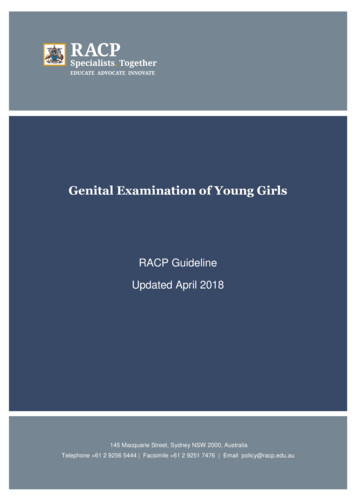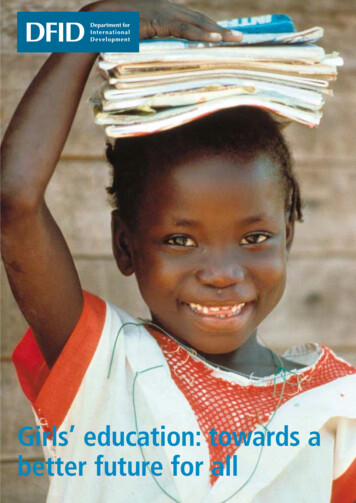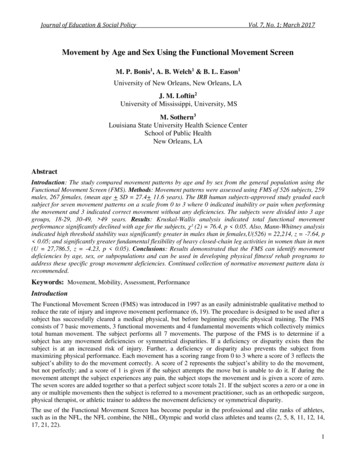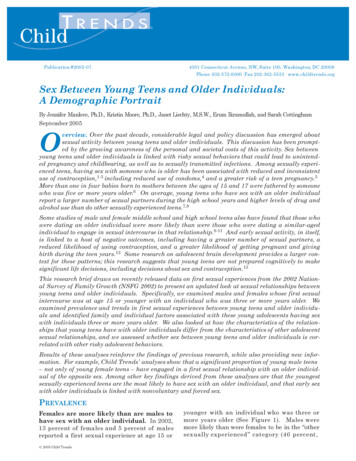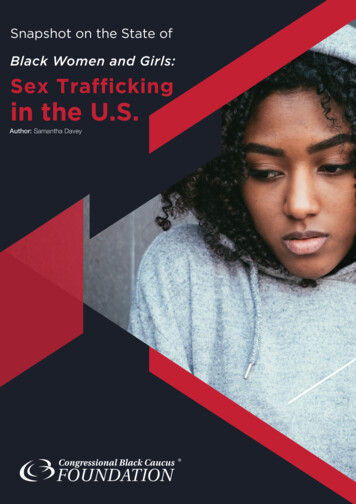
Transcription
Snapshot on the State ofBlack Women and Girls:Sex Traffickingin the U.S.Author: Samantha Davey
Snapshot on the State ofBlack Women and Girls:Sex Traffickingin the U.S.
Snapshot on the State of Black Women and Girls: Sex Trafficking in the U.S.Map of SexTrafficking in the U.S.Source: PolarisOVERVIEW OF FACT SHEETSTo better understand the high rates ofThe importance of analyzing sex traffickingsex trafficking among Black women andis evident, but the factors discussed abovegirls, research has indicated the continuedwhich contribute to the likelihood of beingsexualization of Black women and girls’trafficked are often ignored or overlooked.bodies which has played out since slavery.In order to create a more comprehensiveThe myths around Black women and girls’approach to studying the high rates of sexhypersexuality cannot be ignored whentrafficking among Black women and girls,researching sex trafficking. Furthermore,the intersecting factors must be studied allthe continued treatment of Black girls astogether. By studying the racial disparitiesolder than their age must be exploredacross these particular factors, the blame iswhen looking at the data surrounding theplaced off victims and the larger structuralprevalent rates of domestic sex traffickingimplications are revealed.of Black girls. In addition, the intersectingfactors like low socioeconomic status, childThe objective of these series of fact sheetswelfare involvement, detachment fromis to address the issue of sex trafficking,education, criminal justice involvement, andspecifically among the population of Blackhistory of physical/sexual abuse must bewomen and girls. Throughout this series,addressed. These factors contribute to thethe fact sheets also aim to highlight theincreased vulnerability of sex trafficking.importance of promoting policies whichCompared to their racial counterparts,safeguard Black women and girls.Black women and girls suffer higher ratesof these combined factors.
SEX TRAFFICKINGCompared to their racial counterparts, Black girls are more likelyto be trafficked at a younger age.57.5%According to the FBI,57.5% of all juvenile prostitution arrestsare Black children.40%Through a two-year review of all suspectedhuman trafficking incidents across the country,40% of sex trafficking victims wereidentified as Black women.In an interview with the Urban Institute,traffickers admittedly believe trafficking Blackwomen would land them less jail timethan trafficking White women if caught.Source: Rights 4 Girls, Urban Institute
Snapshot on the State of Black Women and Girls: Sex Trafficking in the U.S.SOCIOECONOMIC STATUSSocioeconomic status is one of the top contributors in increasingthe chances of sex trafficking.Black girls aremore likely to experience povertythan their racial counterparts.Traffickers tend totarget individuals with Black womenwith a low socioeconomic status.Due to unemployment, debt, and need toprovide for themselves and their children,many victims are less likely to leavethe situation to make ends meet.Source: Rights 4 Girls, Institute for Women’sPolicy Research, Polaris
SEXUAL ABUSESexual and physical abuse are two of the top contributors inincreasing the chances of sex trafficking.Black girls are more likely to experiencesexual and physical abuse than their racial counterparts.Women who experience partner violence pose a higher risk of beingsex trafficked. Of women who called the National Hotline,36.9 percent were trafficked by their partners.Along with psychological and economic abuse, sex traffickers are likely toemploy physical and sexual violence over women to maintaincontrol.Source: Rights 4 Girls, Polaris
Snapshot on the State of Black Women and Girls: Sex Trafficking in the U.S.&TRAFFICKINGTRAFFICKERRELATIONSHIPResearch conducted in2012 showed that around85% of those who boughtsex on the internet wereWhite men.In Pennsylvania, 22% ofarrests are for purchasingsex, but only 78% ofprostitution arrests are forselling sex.Source: Grantmakers for Girlsof Color, Rights 4 Girls
THE FOSTER CARESYSTEMChild welfare involvement, specificallyout-of-home foster care placement, isone of the top contributors in increasingthe chances of sex trafficking.Black children are overrepresented inthe foster care system. Although theymake up fourteen percent of children inthe U.S., Black children make uptwenty three percent of the fostercare system.More than 23,000 children will age out ofthe U.S. foster care system every year.After reaching the age of 18, 20% ofthe children who are in foster carewill become instantly homelessA report conducted in 2016 by NCMECfound that 86% of the likely sextrafficking victims were in the careof social services when they wentmissing.Source: Rights 4 Girls, Child Trends, NationalFoster Youth Institute, National Center forMissing and Exploited Children
Snapshot on the State of Black Women and Girls: Sex Trafficking in the U.S.INEQUALITIES IN THE FOSTER CARESYSTEMNot only are Black girls overrepresented in foster care, but they arestructurally disadvantaged by systematic racial disparities within thefoster care system.Black girls are more likely to experience family instability, poverty,disconnection from the education system, and physical andsexual abuse.10XFoster children are 10 times more likely to be sexuallyabused. Black children are sexually abusedtwice as much as their White counterparts inthe foster care system.California is ranked as having the highest number of92%reported cases of human trafficking in the U.S. Thelargest county in California, Los Angeles County,reported 92% of girls in the juvenile justicesystem identified as victims of sex traffickingare Black. Of those, 62% were from the childwelfare system.Source: Rights 4 Girls, Darkness to Light
MISSING AND MURDERED BLACK WOMENBlack women and girls are disproportionately effected in missingand murder statistics.Black girls are more likely torun away from foster care than theirracial counterparts.Black girls who are runaways are more likely tobe targeted by sex traffickers.4.41PER100,000In 2014, the homicide rate forBlack women was 4.41 per 100,000.Source: AFCARS, Polaris, Violence Policy Center
Snapshot on the State of Black Women and Girls: Sex Trafficking in the U.S.“ADULTIFICATION” AND SEXUALIZATIONOF BLACK GIRLSThe Center on Poverty and Inequality created a study which foundthat adults viewed Black girls less innocent and more adult likethan white girls. The sexualization and “adultification” of Black girlscontributes to a school to prison pipeline.The study found that compared to White girls of the same age Black girlswere viewed as in need of less nurturing, less protection, less support,less comfort, are more independent, know more about adult topics, andknow more about sex.Due to attributing these characteristics to Black girls, there may be asuggested influence for law officials to criminalize Black girls, rather thanseeing them as victims.In the context of sex trafficking, discretion “enables racial bias—implicitor explicit—to shape who is viewed as a perpetrator and who is viewedas a victim.”Source: The Center on Poverty and Inequality
DISCIPLINE POLICIES IN SCHOOLSBlack girls are more likely to be disconnected from the educationsystem and be off track for achievement than their racialcounterparts.Black girls are two times more likely to be disciplined for minor infractionslike dress-code violations or loitering. Black girls are two-and-a-half timesmore likely to be punished for disobedience, and three times more likely tobe cited for being disruptive.Black girls were six times more likely to be suspended as their whitecounterparts. Only 2 percent of white females were subjected toexclusionary suspensions in comparison to 12 percent of Black girls.In New York City, Black girls represented 56 percent of all girls disciplined,compared to white girls. In Boston, Black girls are 11x more likely to bedisciplined than their white female peers.Source: The Center on Poverty and Inequality, National Black Women’s JusticeInstitute, Atlantic Philanthropies Black Girls Matter Report
Snapshot on the State of Black Women and Girls: Sex Trafficking in the U.S.JUVENILE JUSTICE SYSTEMDue to discipline policies which push Black girls out of the educationsystem, they are more likely to enter the juvenile justice system.Nationally, the imprisonment rate for Black women is twice that of Whitewomen.Black children represent 53% of all juvenile prostitution arrests.California is ranked as having the highest number of reported cases ofhuman trafficking in the U.S. The largest county in California, Los AngelesCounty, reported 92% of girls in the juvenile justice system identified asvictims of sex trafficking are Black.
CBCF ON THE ISSUECBCF has been dedicated to focusing on research to highlightthe importance of promoting policies to safeguard Black womenand girls.CBCF has partnered with Rights 4 Girls tocollaborate on research, education andoutreach to communities.CBCF will be creating a panel for ALC designedto educate and create solutions thatcounter sex trafficking.CBCF will be partnering with CBC members tofocus on policies designed to combat sextrafficking against Black women and girls.The Untold StoryTrafficking in theBlack CommunityALC’19
Snapshot on the State of Black Women and Girls: Sex Trafficking in the U.S.POLICY RECOMMENDATIONS1Enforce laws in placedecriminalizing sex trafficking52Replace zero-tolerance in schoolswith restorative justices policies63Educate law enforcement on howto identify victims of sex trafficking7Educate communities aboutsex trafficking4Extend more resources to Blackgirls in the foster care system8More legal services andprotections extended to Blackwomen and girlsMore development of diversework forces in child care servicesCreate partnerships betweencommunities, agencies, and otherorganizations to address racialdisparities
POLICY RECOMMENDATIONSAs discussed in the supporting fact sheets, Black women and girls face higher rates of sextrafficking due to institutional barriers within social systems. However, this issue cannot beaddressed without particular attention to the inequalities which persist in institutions. The factsheets discuss the staggering statistics Black women and girls face within the systems offoster care, education, and criminal justice.Although the statistics and experiences of sexpromulgate high suspension and expulsion ratestrafficking are concerning in themselves, policiesamong Black girls and continue to push them out ofaimed at focusing on victims are a solid place tothe classroom, increasing their vulnerability to sexstart in decreasing sex trafficking. The Violencetrafficking. Research shows that by replacing zero-Against Women’s Act (VAWA) passed in 1994,tolerance policies with restorative justice in schools,has been instrumental in protecting victims ofclassrooms become more inclusive and learningsexual violence while giving them more access tooutcomes improve. Specific strategies of restorativeresources once unavailable when escaping sexjustice in schools include teaching social-emotionaltrafficking. To build upon this type of legislation,skills, providing training to teachers on implicit bias,policies like The Reducing the Demand for Humandeveloping policies which distinguish betweenTrafficking Act of 2017 co-introduced by Robin Kellyschool discipline and law enforcement discipline,would promote the safeguarding of Black women byand facilitating community engagement in schools.6targeting traffickers for their crimes.4 Additionally,By implementing these practices, schools havecontinued research and proposed legislation hasbeen shown to become more inclusive and safe,been principle in providing a pathway to treatingcreating increased possibilities for success amongchildren as victims of sex trafficking, rather thanBlack female students. Despite this being theperpetrators. In order to continue to combat sexcase, the present administration has rolled back ontrafficking, policies need to target the purchasers ofvoluntary anti-discriminatory practices that weresex trafficking and hold them accountable for theirinstituted under the Obama administration. By notactions while increasing support services for thoseaddressing the systematic inequalities which persistwho have been trafficked.in the combined effort of the education and criminal5Despite the progress through progressivelegislation, there is still much work to be done.While it is necessary to create legislation to combatsex trafficking, it is equally important to identify thejustice system, Black girls have a higher likelihoodof being pushed out of school. Therefore, Black girlshave a higher chance of being sex trafficked andcriminalized by law enforcement.negative policies which systematically discriminateand exclude Black women and girls from systemswhich are supposed to protect and include them.Zero-tolerance school disciplinary policiesReps. Kelly & Kinzinger Introduce Anti-Trafficking Bill.” Congresswoman Robin KellyRights 4 Girls6Protecting Students’ Civil Rights: The Federal Role in School Discipline”, Learning Policy Institute45
Snapshot on the State of Black Women and Girls: Sex Trafficking in the U.S.Another recommendation includes educatingdevelopment of diverse work forces in child carelaw enforcement on how to identify womenservices. In addition, community based programswho are victims of sex trafficking. Rather thanhave been shown to improve a child’s likelihood forcriminalizing Black women and girls through arrests,success. Family Group Decision Making (FGDM)victims should be supplied with resources. Lawis designed to bring together extended familyenforcement continues to arrest high numbers ofmembers and community members to createBlack women for sex trafficking compared to thesuccess for a child in the foster care system.men who actually pay money for the “service”.By creating partnerships between communities,Furthermore, the law needs to protect Blackagencies, and other organizations, racial disparitieswomen and girls who are victims of sex trafficking.in the foster care system can be discussed andDespite legislation aimed at decriminalizingsocial service providers can connect, educate, andvictims of sex trafficking, law enforcement doesbuild trust within communities.7not always enforce the laws in place dealing withdecriminalizing sex trafficking. Often times, criminaljustice institutions focus on blaming the womenthemselves rather than viewing them as worthyof receiving help. Instead, law enforcement mustprovide necessary resources, like social servicesto help victims receive the help and justice theydeserve.Although there has been recent progressivelegislation focused on combatting sexual violenceagainst Black women and girls, there needs tobe a continued education within communities tounderstand what commercial sexual exploitationis.8 By educating law enforcement, teachers, socialservice providers, and other community membersabout the sexual exploitation Black women andAn additional recommendation is to improve thegirls’ face, more awareness can be raised andchild welfare system in which a disproportionatethese victims will be able to feel more supported.amount of Black girls are part of, and a source forIn addition, legal services and protections they aretraffickers. In order to do so, the foster care systeminclined to receive must continue to be extended tomust extend more resources to African Americanthem.9communities. Studies have shown that implicitbias is prevalent in the child welfare system. Inorder to counter this bias, more training in socialservices needs to be implemented, as well as the“Racial Disproportionality and Disparity in Child Welfare” Child Welfare Information GatewayRights 4 Girls9Rights 4 Girls78
and murder statistics. MISSING AND MURDERED BLACK WOMEN Black girls are more likely to run away from foster care than their racial counterparts. Black girls who are runaways are more likely to be targeted by sex traffickers. In 2014, the homicide rate for Black women was 4.41 per 100,000.



